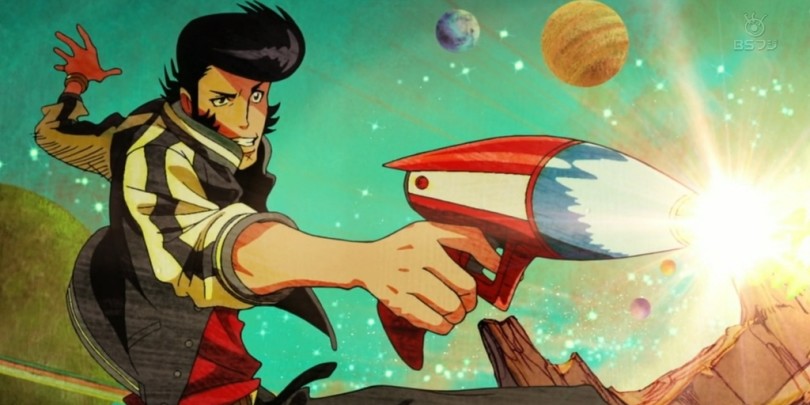I predict 2014 will be remembered by film critics and casual viewers alike as a marked stepping stone in anime’s continued path of expansion outside of Japan, as the medium at large not only becomes more consumable by broader international audiences by way of cultural exchange, but also better understood by educational institutions as a legitimate scholarly outlet. To be fair, this is a reasonably safe bet to make, as anyone who is familiar with the nonsensical escapades of Space Dandy (2014) could attest. The brainchild of veteran director Shinichiro Watanabe, Space Dandy casts a broad viewership net: truly anyone can enjoy the nonlinear, episodic randomness and blatant disregard for narrative coherence, be they television viewers flipping through channels or hardened critics and theorists who need to indulge in a slice of the ludicrous once in a while.
I’m not suggesting that Dandy is junk programming by any means (though when it comes to women, leading man Dandy is about as lewd as they come). Hiding in plain sight among the misadventures of Captain Dandy and his crew is an emphasis on one of the simple secrets of storytelling: plot and setting have their place, but when it comes right down to it the key component for maximum memorability and lasting impressions for any work is its characters. Any work seeking to actively engage its audience on some level has to have impressionable, humanistic agents (even if they’re not technically human), be they humorous, loathsome, or otherwise generally relatable in some way. Taking this emphasis to the extreme—much like a motor vehicle atop a ‘donut’ space-saver spare tire—Watanabe proves that while not exactly ideal, you can get away with pretty much anything as long as the characters are up to par (but, as with the aforementioned spare-tire analogy, for precisely how long is anyone’s guess).
Though again, aspects like continuity and verisimilitude shouldn’t be overlooked and are often essential to a work, Watanabe and the rest of the crew behind Dandy educate with exaggeration (though, like the viewers, I suspect they’re in it mostly just for fun), and if you’re an artist who has proven yourself over and over as Shinichiro Watanabe has, you can get away with arbitrarily throwing any traditional semblance of plot out the window for a few good laughs. Though one can draw conclusions such as these after riding aboard the Aloha Oe with Dandy and company, the program is certainly not cryptic (one could claim, however, that it is mildly esoteric, as there are references to Watanabe’s and other artists’ prior projects interspersed throughout the show).
Existing as simultaneous homage to the likes of Buck Rogers and Flash Gordon while surely being destined to become the subject of future imitations and tributes of its own, the premise of Space Dandy is unabashedly uncomplicated from the start. The introduction adequately sums up the show by plainly telling us before each episode, “Space Dandy: he’s a dandy guy…in space” (“Live With the Flow, Baby”). It’s simple surface-level silliness, yet in an unexpectedly insightful way akin to past greats like John Ford, it contributes to a message concerning not only the artistic process, but also life itself: it’s not about the destination, but rather the journey, and by extension the people who embark on it.
Seeing as how it doesn’t take itself seriously in any way, it’s quite humorous that Space Dandy is seen by some as anime’s best chance of being perceived as a viable artistic and commercial medium (Kim, theatlantic.com). It’s ironic that there is likely much truth to be had in such postulations, since Space Dandy has already made history as the first anime to be broadcasted simultaneously in both Japan and the United States, as well as many other countries (with the possible exception of Kurokami, which is said to have aired simultaneously in Japan, South Korea, and the United States albeit only in select markets). In fact, so much enthusiasm was garnered for the series abroad that each English-dubbed episode premiered on the U.S. Adult Swim lineup before it did in Japan (animenewsnetwork.com).
Even before its highly anticipated second season debuted, Space Dandy had already accumulated an enthusiastic global fan base from its breakout first season due to ambitious marketing techniques on the part of broadcasters and Shinichiro Watanabe’s penchant for remaining prolific rather than resting on his laurels—admittedly, its director’s fondness for classic Americana (including pompadours that would make Elvis Presley envious) probably didn’t hurt its chances stateside, either. As anime gradually becomes more acclimated to the mainstream cultural currents of the international viewing community (and, perhaps equally as important, vice versa), it is clearly evident that even more people will soon come to recognize its popularity in the future…and that’s just fine and dandy with me.
© 2016
Works Cited
Kim, Monica. “Can Cowboy Bebop’s Creator Make More People Take Anime
Seriously?” The Atlantic. The Atlantic Mag. 3 Jan. 2014. Web. 12 Mar. 2016.
“Live With the Flow, Baby.” Space Dandy. Adult Swim. TBS, Atlanta. 4 Jan.
2014. Television.
“Space Dandy to Air on Toonami Before it Airs in Japan.” Anime News Network.
Anime News Network. 25 Oct. 2013. Web. 12 Mar. 2016.
Originally posted here (original version).
Revised and re-posted with permission here (current version).







